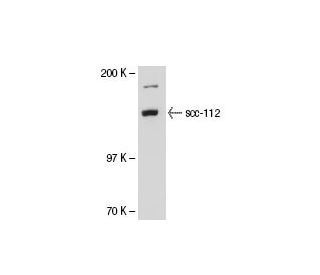


SW480 nuclear extract: sc-2155
- supplied in four vials, each containing 250 µg nuclear extract in 50 µl buffer
- provided in 20 mM HEPES (pH 7.9), 20% v/v glycerol, 0.1 M KCI, 0.2 mM EDTA, 0.5 mM PMSF and 0.5 mM DTT
- human nuclear extract; colorectal adenocarcinoma cells
- suitable for use in Gel Shift and Western Blotting assays
- Extracts should be stored at -70°C and repeated freezing and thawing should be avoided.
- prepared by the method of Dignam et al., (1983) Nucleic Acids Res. 11: 1475
QUICK LINKS
SEE ALSO...
SW480 nuclear extract, derived from the SW480 cell line originating from human colorectal adenocarcinoma, is pivotal in studying the nuclear processes related to cancer cell biology, particularly in colorectal cancer. This extract is enriched with transcription factors and other nuclear proteins involved in cell cycle regulation, apoptosis, and cellular differentiation. Researchers employ SW480 nuclear extract primarily to investigate transcriptional regulation mechanisms by conducting electrophoretic mobility shift assays (EMSA) to monitor DNA-protein interactions, and chromatin immunoprecipitation (ChIP) assays to explain the role of specific transcription factors and histone modifications in gene expression. Additionally, these extracts are used in co-immunoprecipitation experiments to explore protein-protein interactions within the nucleus, providing insights into the signaling pathways that are critical for tumor growth and progression. The use of SW480 nuclear extract helps researchers to understand the fundamental aspects of cancer cell genetics and molecular biology. Ensuring the authenticity and provenance of the SW480 cell line is crucial to maintain the validity and reliability of the experimental outcomes in cancer research.
SW480 nuclear extract References:
- The cyclin D1 gene is a target of the beta-catenin/LEF-1 pathway. | Shtutman, M., et al. 1999. Proc Natl Acad Sci U S A. 96: 5522-7. PMID: 10318916
- The APC tumor suppressor counteracts beta-catenin activation and H3K4 methylation at Wnt target genes. | Sierra, J., et al. 2006. Genes Dev. 20: 586-600. PMID: 16510874
- The rate of base excision repair of uracil is controlled by the initiating glycosylase. | Visnes, T., et al. 2008. DNA Repair (Amst). 7: 1869-81. PMID: 18721906
- Global regulator SATB1 recruits beta-catenin and regulates T(H)2 differentiation in Wnt-dependent manner. | Notani, D., et al. 2010. PLoS Biol. 8: e1000296. PMID: 20126258
- UNG-initiated base excision repair is the major repair route for 5-fluorouracil in DNA, but 5-fluorouracil cytotoxicity depends mainly on RNA incorporation. | Pettersen, HS., et al. 2011. Nucleic Acids Res. 39: 8430-44. PMID: 21745813
- Human FasL gene is a target of β-catenin/T-cell factor pathway and complex FasL haplotypes alter promoter functions. | Wu, J., et al. 2011. PLoS One. 6: e26143. PMID: 22022540
- Identification of DNA-dependent protein kinase catalytic subunit as a novel interaction partner of lymphocyte enhancer factor 1. | Shimomura, A., et al. 2013. Med Mol Morphol. 46: 14-9. PMID: 23325550
- Identification and characterization of functional risk variants for colorectal cancer mapping to chromosome 11q23.1. | Biancolella, M., et al. 2014. Hum Mol Genet. 23: 2198-209. PMID: 24256810
- Gut microbiota-dependent adaptor molecule recruits DNA methyltransferase to the TLR4 gene in colonic epithelial cells to suppress inflammatory reactions. | Narabayashi, H., et al. 2022. Front Mol Biosci. 9: 1005136. PMID: 36339704
- Expression of Concern: Global Regulator SATB1 Recruits β-Catenin and Regulates TH2 Differentiation in Wnt-Dependent Manner. | ,. 2022. PLoS Biol. 20: e3001908. PMID: 36417696
Ordering Information
| Product Name | Catalog # | UNIT | Price | Qty | FAVORITES | |
SW480 nuclear extract | sc-2155 | 250 µg/0.05 ml | $160.00 |
